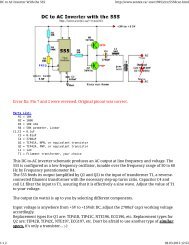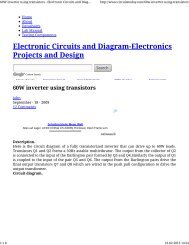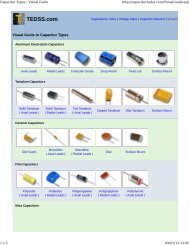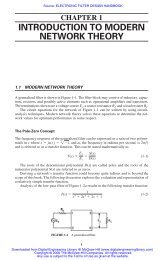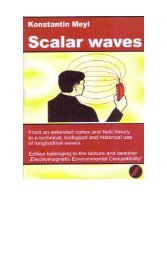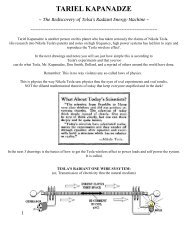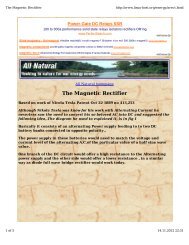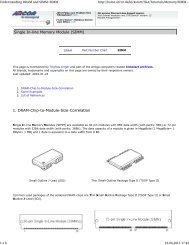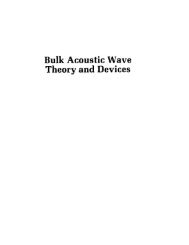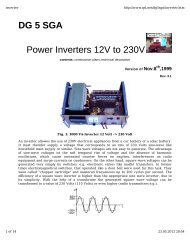New Energy Technologies Magazine nr 3 2005.pdf - Index of
New Energy Technologies Magazine nr 3 2005.pdf - Index of
New Energy Technologies Magazine nr 3 2005.pdf - Index of
You also want an ePaper? Increase the reach of your titles
YUMPU automatically turns print PDFs into web optimized ePapers that Google loves.
weight <strong>of</strong> the left ones by the weight <strong>of</strong> the<br />
water filling the useful capacities, an<br />
additional force will influence the right side<br />
<strong>of</strong> the belt and create a rotary moment <strong>of</strong> the<br />
systems:<br />
Z=mgNR (1),<br />
where m is the mass <strong>of</strong> the water in the useful<br />
capacity; g is the acceleration <strong>of</strong> free fall; N<br />
is the number <strong>of</strong> the cylinders filled with<br />
water in the vertical sector <strong>of</strong> the belt; R is<br />
the wheel's radius.<br />
Thus, the belt will rotate clockwise. When the<br />
cylinder filled with water will pass the lowest<br />
point and occupy a vertical position, the<br />
piston will press the water out <strong>of</strong> the cylinder<br />
under the influence <strong>of</strong> gravity force. At the<br />
same time, in the upper cylinder, which is<br />
connected with it, the piston will go down<br />
under the influence <strong>of</strong> the weight and draw<br />
the water from the lower cylinder into its<br />
useful capacity. Both weights will operate in<br />
the same direction under the influence <strong>of</strong><br />
gravity force overcoming a pressure <strong>of</strong> a<br />
liquid spout with height H (where h is an<br />
upright distance from the bottom <strong>of</strong> the left<br />
lower cylinder to the bottom <strong>of</strong> the right<br />
upper one). A condition <strong>of</strong> the water raise will<br />
be determined by the excess <strong>of</strong> the sum <strong>of</strong><br />
pressures created by two weights over a<br />
pressure created by water spout H:<br />
2Mg/s ρgH (2),<br />
where M is the mass <strong>of</strong> the weight; s is the<br />
sectional area <strong>of</strong> the cylinder's useful<br />
capacity; ρ is the specific density <strong>of</strong> the liquid.<br />
it follows that an optimal height <strong>of</strong> water<br />
rises:<br />
H = 2M/sρ (3).<br />
Due to the fact that, if the lower cylinder is<br />
located vertically, the water from it raises up<br />
to height H in the upper cylinder, which is<br />
connected with it, the system increases its<br />
potential energy by a value <strong>of</strong><br />
E 0<br />
= mgH (4)<br />
under the influence <strong>of</strong> gravity force inside the<br />
cylinders. The water mass corresponds with<br />
the cylinder's useful capacity:<br />
m = ρsL (5),<br />
where L is a length <strong>of</strong> the useful capacity.<br />
Using (4) and taking into account (3) and (5),<br />
the potential energy increase can be<br />
expressed as<br />
E 0<br />
= 2MgL (6),<br />
which is equivalent to the work produced<br />
during motion <strong>of</strong> the weights under the<br />
influence <strong>of</strong> gravity force in both cylinders.<br />
Thus, the described system is a gravity<br />
engine <strong>of</strong> perpetual mobile type able to<br />
produce yield using only gravity force.<br />
Thus, the gravity engine's power will be<br />
determined by a quantity <strong>of</strong> the cylinders<br />
passing through a permanent point <strong>of</strong> the<br />
system (n) per second and efficiency (η)<br />
taking into account friction losses:<br />
W=nE 0<br />
η (7)<br />
Under permanent speed <strong>of</strong> the belt's motion<br />
(V):<br />
n=V/(L+d) (8),<br />
where d is the interval between adjoining<br />
capacities <strong>of</strong> the cylinders. Putting (7) into<br />
expressions (6) and (8), we obtain an<br />
expression <strong>of</strong> the power as:<br />
W=2MgVηL/(L+d) (9)<br />
It can be seen that a maximal power can be<br />
obtained by a possible increase <strong>of</strong> the belt's<br />
motion and placing the cylinders on the belt<br />
with minimal allowable intervals.<br />
However, it is early to talk about efficiency<br />
and future possibilities <strong>of</strong> the gravity engine<br />
without making an experimental test.<br />
The author would be thankful for critics and<br />
discussion the model proposed.<br />
24 <strong>New</strong> <strong>Energy</strong> <strong>Technologies</strong> #3(22) 2005



